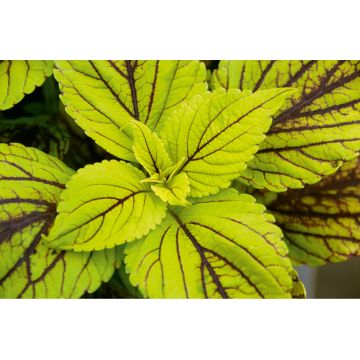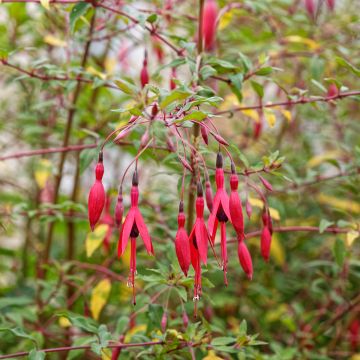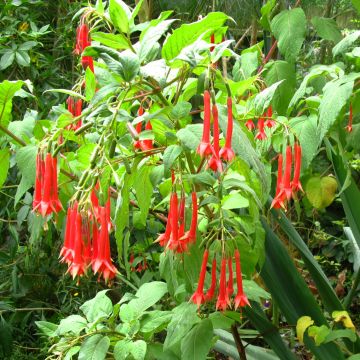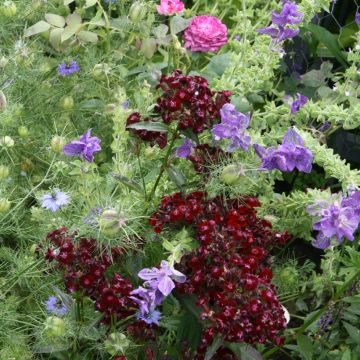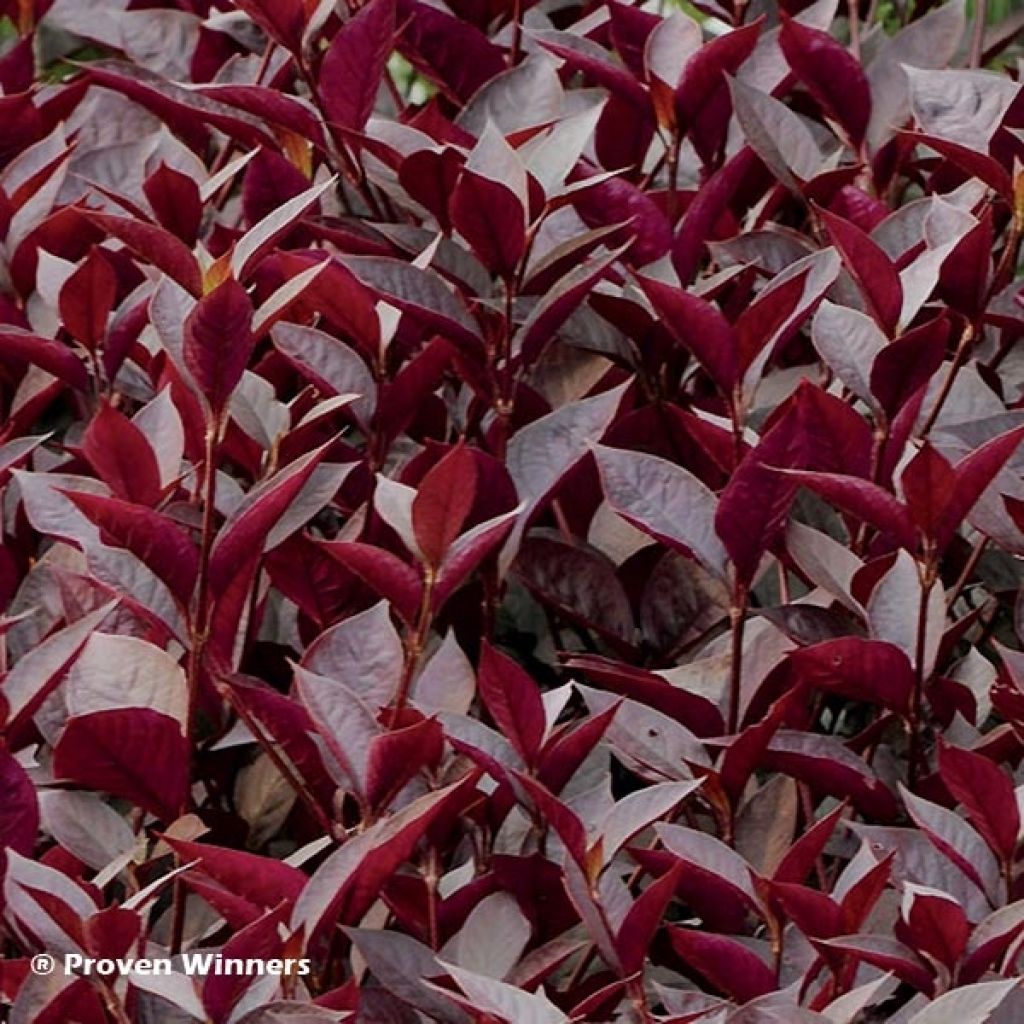

Alternanthera Purple Knight


Alternanthera Purple Knight


Alternanthera Purple Knight
Alternanthera Purple Knight - Joseph's Coat
Alternanthera Purple Knight
Joseph's Coat
This item cannot be shipped to the selected country
Delivery charge from €5.90
More information
Schedule delivery date,
and select date in basket
This plant carries a 6 months recovery warranty
More information
We guarantee the quality of our plants for a full growing cycle, and will replace at our expense any plant that fails to recover under normal climatic and planting conditions.
From €5.90 for pickup delivery and €6.90 for home delivery
Express home delivery from €8.90.
Does this plant fit my garden?
Set up your Plantfit profile →
Description
The Purple Knight Alternanthera is an unknown plant, rarely offered when it comes to creating floral compositions in which its entirely purple to violet vegetation works wonders. Cultivated as an annual in our climates, this frost-sensitive plant forms a large, bushy and flexible tuft of remarkable colour in just one season, which enhances all its neighbors, whether it is planted in a pot, in flower boxes, hanging or in the ground in a temporary flower bed. An aficionado of heat, a hundred times more beautiful in full sun, 'Purple Knight' is easily grown in a good potting soil that stays moist. In the ground, the alternanthera tolerates relatively dry soils.
Belonging to the chenopodiaceae family, the Alternanthera dentata is related to spinach and amaranth. Native to the West Indies and Brazil, it is a perennial herbaceous plant that perishes below -1°C (30.2°F). With rapid growth, it forms a spreading tuft that will reach about 45 cm (18in) in height and spread over a minimum of 70 cm (28in) on the ground. In 'Purple Knight', growth starts as soon as temperatures rise, in April-May. The stems and leaves are entirely coloured in shades of red, purple, violet, and almost black in full sun, more bronzed in semi-shaded exposure. The leaves, with a satin appearance, are elongated and pointed, finely toothed, and reveal a reverse side of striking ruby red. The summer flowering consists of small inconspicuous pompom-shaped red flowers that appear in the axils of the leaves. It is undoubtedly for its decorative foliage that this annual is cultivated.
Magnificent in pots, Purple Knight Alternanthera can also be used to create sumptuous borders along paths or flower beds. It will be used as a contrasting plant to accompany light foliage (columbines, chamomiles, Diamond Frost Euphorbia), gray or white plants (sea cineraria, Senecio Angel Wings, Silver Falls Dichondra), golden tones, as well as all annual or perennial flowers. In a large hanging basket, combine it with bright blue lobelias and a pink petunia, for example. In a different style, pair it with a pink verbena, an orange marigold, and a red pendula begonia. At the base of a tree, this plant will also create magnificent temporary carpets. With large purple sedums (Purple Emperor), this Alternanthera will add tremendous charm to the late season.
Note: Please be aware that our young plug plants are professional products reserved for experienced gardeners: upon receipt, replant them as soon as possible, in pots, flower boxes, or directly in flower beds.
Report an error about the product description
Alternanthera Purple Knight - Joseph's Coat in pictures




Flowering
Foliage
Plant habit
Botanical data
Alternanthera
Purple Knight
Chenopodiaceae
Joseph's Coat
Cultivar or hybrid
Other Annuals A to Z
Planting and care
The Purple Knight Alternanthera dentata is cultivated in full sun (to enhance the foliage colours) or, at a push, in partial shade. Plant it in a good potting soil that should remain moist. In open ground, mix your garden soil with potting soil in equal parts (excessive limestone is feared). Water regularly. A universal fertilizer will be appreciated by plants grown in pots and hanging baskets. It is a frost-sensitive plant, which perishes below -1°C (30.2°F). You can shelter it in winter in a slightly heated conservatory.
Planting period
Intended location
Care
-
, onOrder confirmed
Reply from on Promesse de fleurs
Plug plants - Annuals
Haven't found what you were looking for?
Hardiness is the lowest winter temperature a plant can endure without suffering serious damage or even dying. However, hardiness is affected by location (a sheltered area, such as a patio), protection (winter cover) and soil type (hardiness is improved by well-drained soil).

Photo Sharing Terms & Conditions
In order to encourage gardeners to interact and share their experiences, Promesse de fleurs offers various media enabling content to be uploaded onto its Site - in particular via the ‘Photo sharing’ module.
The User agrees to refrain from:
- Posting any content that is illegal, prejudicial, insulting, racist, inciteful to hatred, revisionist, contrary to public decency, that infringes on privacy or on the privacy rights of third parties, in particular the publicity rights of persons and goods, intellectual property rights, or the right to privacy.
- Submitting content on behalf of a third party;
- Impersonate the identity of a third party and/or publish any personal information about a third party;
In general, the User undertakes to refrain from any unethical behaviour.
All Content (in particular text, comments, files, images, photos, videos, creative works, etc.), which may be subject to property or intellectual property rights, image or other private rights, shall remain the property of the User, subject to the limited rights granted by the terms of the licence granted by Promesse de fleurs as stated below. Users are at liberty to publish or not to publish such Content on the Site, notably via the ‘Photo Sharing’ facility, and accept that this Content shall be made public and freely accessible, notably on the Internet.
Users further acknowledge, undertake to have ,and guarantee that they hold all necessary rights and permissions to publish such material on the Site, in particular with regard to the legislation in force pertaining to any privacy, property, intellectual property, image, or contractual rights, or rights of any other nature. By publishing such Content on the Site, Users acknowledge accepting full liability as publishers of the Content within the meaning of the law, and grant Promesse de fleurs, free of charge, an inclusive, worldwide licence for the said Content for the entire duration of its publication, including all reproduction, representation, up/downloading, displaying, performing, transmission, and storage rights.
Users also grant permission for their name to be linked to the Content and accept that this link may not always be made available.
By engaging in posting material, Users consent to their Content becoming automatically accessible on the Internet, in particular on other sites and/or blogs and/or web pages of the Promesse de fleurs site, including in particular social pages and the Promesse de fleurs catalogue.
Users may secure the removal of entrusted content free of charge by issuing a simple request via our contact form.
The flowering period indicated on our website applies to countries and regions located in USDA zone 8 (France, the United Kingdom, Ireland, the Netherlands, etc.)
It will vary according to where you live:
- In zones 9 to 10 (Italy, Spain, Greece, etc.), flowering will occur about 2 to 4 weeks earlier.
- In zones 6 to 7 (Germany, Poland, Slovenia, and lower mountainous regions), flowering will be delayed by 2 to 3 weeks.
- In zone 5 (Central Europe, Scandinavia), blooming will be delayed by 3 to 5 weeks.
In temperate climates, pruning of spring-flowering shrubs (forsythia, spireas, etc.) should be done just after flowering.
Pruning of summer-flowering shrubs (Indian Lilac, Perovskia, etc.) can be done in winter or spring.
In cold regions as well as with frost-sensitive plants, avoid pruning too early when severe frosts may still occur.
The planting period indicated on our website applies to countries and regions located in USDA zone 8 (France, United Kingdom, Ireland, Netherlands).
It will vary according to where you live:
- In Mediterranean zones (Marseille, Madrid, Milan, etc.), autumn and winter are the best planting periods.
- In continental zones (Strasbourg, Munich, Vienna, etc.), delay planting by 2 to 3 weeks in spring and bring it forward by 2 to 4 weeks in autumn.
- In mountainous regions (the Alps, Pyrenees, Carpathians, etc.), it is best to plant in late spring (May-June) or late summer (August-September).
The harvesting period indicated on our website applies to countries and regions in USDA zone 8 (France, England, Ireland, the Netherlands).
In colder areas (Scandinavia, Poland, Austria...) fruit and vegetable harvests are likely to be delayed by 3-4 weeks.
In warmer areas (Italy, Spain, Greece, etc.), harvesting will probably take place earlier, depending on weather conditions.
The sowing periods indicated on our website apply to countries and regions within USDA Zone 8 (France, UK, Ireland, Netherlands).
In colder areas (Scandinavia, Poland, Austria...), delay any outdoor sowing by 3-4 weeks, or sow under glass.
In warmer climes (Italy, Spain, Greece, etc.), bring outdoor sowing forward by a few weeks.






































